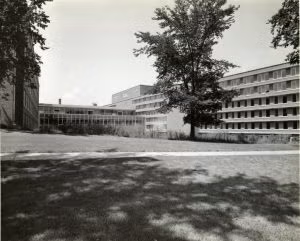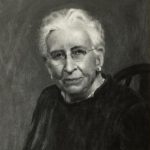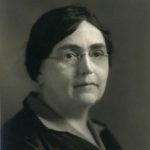
The story of the naming of what is officially known as Mary Butler Markley Hall begins earlier than one might think. The idea of putting the Markley name on a University building first came up in the year 1944, when the alumnae council concluded that the residence building named the “Alumnae House” (which was a literal house) needed a name change. This desired name change was due to the fact that it was commonly mistaken for a graduate residence and accordingly was “omitted from directories or listings of undergraduate houses.” For this reason, the residents of the house suggested the house be named Mary Markley, “in honor of a very loyal friend and an honorary member of Alumnae House Board.” In a letter to the Board of Governors, the Markley planning committee suggested that the students had a particular relationship with the New York native: “Her home on Geddes Avenue at Oxford was a place that the students knew well.” The name was meant to resemble some of the women’s houses that were already in existence at the time, such as Betsy Barbour and Martha Cook. Based on this push from the residents of the house, the Alumnae Council unanimously approved the name change through a vote, which was then approved by the Board of Regents.[1]
This house was eventually closed in 1950, but upon its closing, the Board of Regents added a note that the name should be considered for a future residence hall. This came into effect six years later, in 1956, when it came time to name a new women’s residence hall. The University was having trouble, as rising enrollment had led to a shortage of space in women’s dormitories. The University philosophy was that all women were to live on campus, but the capacity was simply not enough. Eventually, senior females were allowed to live in apartments, unsupervised, but the construction of this all women’s hall was meant to alleviate the predicament. With the construction of a new women’s hall came the responsibility to give it a name to represent it.[2] A memo written to the Dean of Women by one F.C. Shiel included a reminder of the aforementioned note in light of Markley’s death during the same year.[3] In November 1956, when it came time to pick a name, the Board of Regents turned to a method that had apparently been used before: “In the past it has been customary to present two names from which the Regents choose. My office has received several communications from prominent individuals and organizations suggesting the names of Hazel Whitaker Vandenberg and Mary Butler Markley.” Based on two short biographies of the two women, which included their contributions to the University, the Regents voted, and decided on the name Mary Butler Markley Hall.
It is difficult to know exactly why Markley was selected over Vandenberg, but some clues may lie in the short biographies that were used in the decision-making process. It seems that Markley was more directly involved with the university and, particularly, with the advancement of women. She was active during her time as a student at Michigan, and accomplished being elected to the Phi Beta Kappa honor society upon its establishment there. She also helped found the Michigan League. After graduation, she stayed in the Ann Arbor area. She stayed active in alumnae affairs and even kept a relationship with some students. Furthermore, Markley organized the Ann Arbor branch of the American Association of University Women. Upon her death, she left $5,000 to the organization to be used for financial aid for women who wanted to attend the university. Vandenberg also made important contributions to the advancement of women at U-M, but it seems that her efforts were not as concentrated. Nonetheless, a room in the Michigan League is named the Vandenberg Room to this day.
Once the hall was named, the final step was to find names for the houses inside. The spirit of naming these houses and the hall as a whole is encompassed in the following note, which served as a proposal for the house names from the Markley Hall Planning Committee: “Charlotte Alice Blagdon, Barbara Jane Little, Betty Vaughn Thronson, Margaret Salisbury Bush, Elizabeth Ruth Vandergrift, Barbara Lovell Warren, and Josephine Rankin Fisher… In selecting these particular women, our primary interest was their contribution to campus life while they were attending the University. Because we want the students to feel a closeness to their houses, and a unity within them, we would like to have these houses named in honor of women who were recognized as campus leaders. We hope that their activities will act as an inspiration to the girls living in the houses, and at the same time we would like to see these women honored for their contribution as young people at the University.” In essence, it seems as though the committee was mainly seeking alumnae who had made significant contributions while attending the university, both to honor these women and to inspire current women students.[4]
Of the proposed names, Blagdon, Little, and Fisher were founded and remain at Markley Hall to this day. Thronson and Bush began at Markley but were transferred to South Quadrangle in 1963, when both of these residence halls became coed. Vandergrift and Warren did not make the cut and their names seemingly do not appear anywhere in the University. In any case, the proposal of all of these women carries a constant theme: female campus leaders. This is the clear intent of those who were in charge of naming the houses inside of the hall, and this idea seems to apply to Mrs. Mary Markley herself. In using these women’s names to identify this residence hall and its houses, it seems clear that the University successfully honors the work that they did at the university. As for inspiring residents, we can only hope that the names fulfilled this purpose, both in 1957 and today.
Click on the images below to learn more about the names chosen for Mary Markley Hall:

Mary Butler Markley |

Orma Fitch Butler |
Notes:
- Letter from Alumnae Council to Shirley Smith, May 12, 1944, Box 52, Board of Regents Records.
- Howard H. Peckham, The Making of the University of Michigan 1817-1992, (Ann Arbor, Michigan: University of Michigan Library, 2005), p. 258.
- Letter from F.C. Shiel to Deborah Bacon, March 14, 1956, Box 4, University Housing Records.
- Board of regents records pertaining to the naming of new women’s residence hall, November 16, 1956, Box 83, Board of Regents Records.
Image Credit:
“Mary Markley Residential Hall for Women,” 1958, Alumni Association Records.



